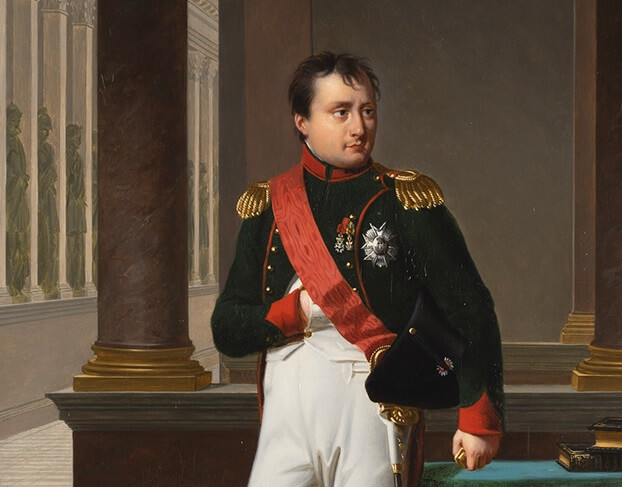What do J. Lo, Banksy and the Queen have in common? Wealth, sure; devoted supporters, absolutely; but we’re talking about a carefully curated public image – propaganda, if you will. The tools at the disposal of today’s public figure, whether an artist, actor, monarch or politician, are seemingly endless: a team of PR agents, multiple social media channels, established relationships with the press, publicists, stylists, photographers, and many more. Together, these tools allow those in the public eye to disseminate, and promote, the identity the world comes to know. But the importance of good publicity didn’t originate in the modern era, and, long before Kim Kardashian was posting selfies on Instagram, Napoleon Bonaparte was using all of the tools at his disposal to curate and communicate a very particular public image, to great effect. In this week’s insight, and to mark the Bicentenary of Napoleon’s death in 1821, we’ll be taking a look at how he used imagery to shape his own public identity and legacy.
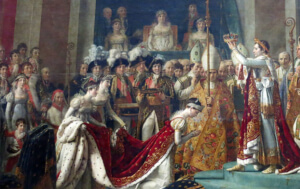

J.L. David, The Coronation of Napoleon (detail), 1805-07, Musée du Louvre, Paris
When Napoleon rose to power, he sought to align himself with the Roman Emperors, leaders such as Augustus and Constantine. Like many, he held an idealised view of the Roman Empire, admiring it as a civilisation that was powerful, wisely governed, and responsible for some of the most celebrated art and monuments. Like the Romans, Napoleon commissioned a series of medals to commemorate important victories in battle. And when Napoleon was crowned Emperor, on 2 December 1804 at Notre Dame, he wore a gold laurel wreath reminiscent of Ancient Roman champions’ wreaths. This event, with its elaborately staged pageantry, was captured by Neoclassical painter Jacques-Louis David in a monumental work stretching nearly 10 meters wide (1805-07), The Coronation of Napoleon, which depicts the new Emperor crowning his Empress Josephine.
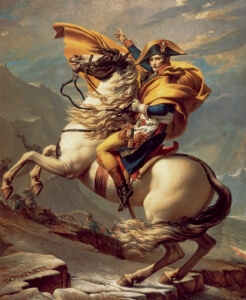

J.L. David, Napoleon Crossing the Alps, 1801, Château de Malmaison, Rueil-Malmaison
Indeed, one of Napoleon’s most valuable propaganda tools was his relationship with the most celebrated artists of the day. Before he painted the coronation scene, David was responsible for another of Napoleon’s most iconic images, Napoleon Crossing the Alps (1801). In this work, we see then-First Consul Napoleon astride a rearing white horse, raising his right hand in a commanding gesture. His cape, and the horse’s mane and tail, billow in the fierce wind; together with the steep incline of the mountainous terrain, these elements lend the composition an intense dynamism. Napoleon himself liked the painting so much that a total of five versions (including one retained by David in his studio) were eventually produced.
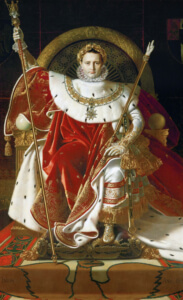

J.A.D. Ingres, Napoleon I on his Imperial Throne, 1806, Musée de l’Armée, Les Invalides, Paris
Like David, Jean-Auguste-Dominique Ingres was charged with painting a coronation portrait of Napoleon. Unlike David’s multi-figure narrative episode, however, Napoleon I on his Imperial Throne (1806) focuses on the sole figure of the Emperor, viewed frontally and from below, as though by a devoted subject kneeling before the throne. Once again, Napoleon is depicted in the gold laurel wreath in lieu of a crown, holding the Imperial sceptre and identified by other regalia of state. His pose is based on a number of artistic precedents, including the colossal statue of Zeus at Olympia by Phidias, and Jan van Eyck’s figure of God the Father in the Ghent Altarpiece. As a piece of propaganda, it doesn’t get much more ambitious than this!
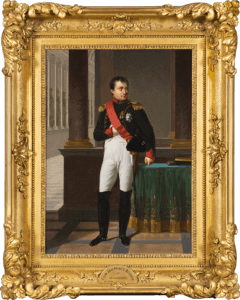

R. Lefevre, The Emperor Napoleon, 1814, available for sale at Dickinson
Yet another of the Emperor’s favourite artists was Robert Lefevre. Portraits of Napoleon were valuable records despite his notorious refusal to sit to any painter: artists were required to follow him, sketching, as he went about his business. In this 1814 portrait, executed shortly before Napoleon’s fall from power in the same year, the Emperor wears the silver star and red taffeta sash of the Légion d’Honneur, the highest accolade bestowed by the French state. The keys held in his left hand suggest his stewardship of the nation, while the quintessentially Napoleonic gesture of the right hand tucked into his waistcoat was first adopted during military campaigns in Russia, when anxiety brought on an episode of ill health. He stands in a Neoclassical colonnade filled with sculpted figures of monarchs and philosophers, a positioning that implicitly underscores Napoleon’s own status. On the table to his left sits a copy of the Code Napoleon, a code of law still referenced in France and the basis of the legislature in the former French colony of Louisiana in the United States. None of these artistic choices was accidental; all were deliberate details designed to further align Napoleon with the great leaders of history.
Napoleon declared in 1812: ‘I am a true Roman Emperor; I am of the best race of the Caesars – those who are founders.’ The artists he entrusted with the task of capturing and disseminating his likeness, such as David and Lefevre, contributed to this convincing image of power, wisdom and nobility.
For enquiries about Robert Lefevre’s The Emperor Napoleon, 1814, please contact: [email protected]


